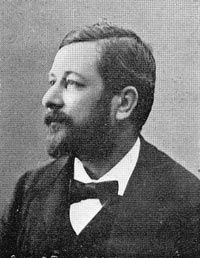- Félix Tisserand
Infobox Scientist
name = François Félix Tisserand
box_width =
image_width = 200px
caption =
birth_date =January 13 ,1845
birth_place =Nuits-Saint-Georges ,Côte d'Or
death_date =October 20 ,1896
death_place =
residence =
citizenship =
nationality =France
ethnicity =
field =Astronomy
work_institutions =Paris Observatory
alma_mater =
doctoral_advisor =
doctoral_students =
known_for = "Traité de mécanique céleste"
author_abbrev_bot =
author_abbrev_zoo =
influences =
influenced =
prizes =
religion =
footnotes =François Félix Tisserand (
January 13 ,1845 -October 20 ,1896 ) was a Frenchastronomer .Tisserand was born at
Nuits-Saint-Georges ,Côte d'Or . In 1863 he entered the Ecole Normale Superieure, and on leaving he went for a month as professor at the lycee atMetz .Urbain Le Verrier offered him a post in theParis Observatory , which he entered as astronome adjoint in September 1866. In 1868 he took his doctor's degree with a thesis on Delaunay's Method, which he showed to be of much wider scope than had been contemplated by its inventor. Shortly afterwards he went out toMalacca to observe the solar eclipse ofAugust 18 1868 .In 1873 he was appointed director of the observatory at
Toulouse , where he published his "Recueil d'exercices sur le calcul infinitesimal", and in 1874 became corresponding member of the Académie des Sciences. He took part in the French expeditions of 1874 toJapan , and in 1882 toMartinique to observe the transits of Venus. In 1878 he was elected a member of the Académie des Sciences in succession to Le Verrier, and became a member of theBureau des Longitudes . In the same year he was appointed professeur suppliant to Liouville, and in 1883 he succeeded Puiseux in the chair ofcelestial mechanics at the Sorbonne.Tisserand always found time to continue his important researches in mathematical astronomy, and the pages of the "Comptes rendus" bear witness to his activity. His writings relate to almost every branch of celestial mechanics, and are always distinguished by rigour and simplicity in the solution of the most difficult problems. He treated in a masterly manner ("Bulletin astronomique", 1889) the theory of the capture of comets by the larger planets, and in this connection published his valuable "Criterion" for establishing the identity of a periodic
comet , whatever may have been the perturbations brought about in its orbit, between successive appearances, by the action of a planet.His principal work, "Traité de mécanique céleste", is the most lasting monument to his memory, and is worthy to stand beside the "Mécanique céleste" of his fellow-countryman, Laplace. In this treatise, published in four quarto volumes, the last of which appeared only a few months before his death, he fused into one harmonious whole the researches of Laplace and those of other workers in the same field since his time. It furnishes a faithful and complete résumé of the state of knowledge in that department of astronomy at the end, as Laplace's great work did for the beginning, of the 19th century.
In 1892 he succeeded Mouchez as director of the Paris Observatory, and as president of the committee of the photographic chart of the heavens he contributed largely to the success of that great project. Under his direction the revision of Lalande's catalogue was brought almost to completion, and four volumes of the "Annales de l'Observatoire de Paris" exhibit the progress made in this important undertaking. He was also editor of the "Bulletin astronomique" from the beginning, and contributed many important articles to its pages. He died suddenly, in the fullness of his power, of congestion of the brain.
Tisserand crater, on the
Moon , is named after him.References
*1911
External links
*
Wikimedia Foundation. 2010.
